Back to my notes from Biorama, a one day event organized by Capsula and the Digital Research Unit on July 13 in Huddersfield. The event brought together an exciting bunch of artists whose work explores notions of life, science and digital realities.
Laura Cinti (who is currently doing some research on the way plants can be modified in order to be visually responsible to touch) and Howard Boland from c-lab (interviewed then a few months ago) focused mainly on their fascinating Martian Rose project.
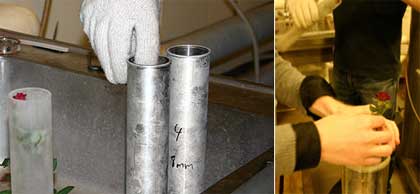
How would the aesthetics of the flower start to break down if exposed to the Mars environment? Would it still have petals? The project started as a very romantic idea: offering a rose to Mars. They worked with scientists from the Mars Simulation Laboratory, at the University of Aarhus in Denmark.
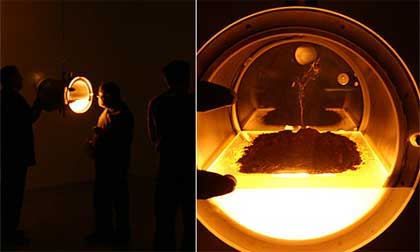
The artists and the scientists put roses inside a vacuum chamber built to simulate parameters such as temperature, gas and distribution, pressure and radiation.
Bacteria can go into suspension and survive after exposure to extreme environment, they will event produce new patterns. The roses, however, were not too happy with the experiment. After several hours of exposure the flowers were significantly darker in colour. As they warmed up, they would easily collapse having been exposed to low pressure.
One of the roses is currently exhibited at BIOS 4, a show on biotechnological and environmental art at the Centro Andaluz de Arte Contemporaneo in Seville, Spain.
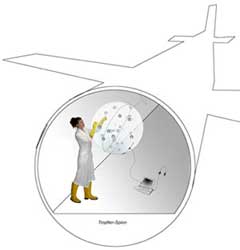 After Laura and Howard, it was the turn of Agnes Meyer-Brandis to present her work. I had her talk about her projects a few months ago, so i decided to drop the pen and paper and just enjoy her witty talk full of iceberg drifting along the Brazilian coast, elves and other mysterious phenomena. Agnes is currently working on her latest project the Cloud Core Scanner, an artistic experiment in weighlessness within the scope of the German Aerospace Center‘s parabolic flight campaign.
After Laura and Howard, it was the turn of Agnes Meyer-Brandis to present her work. I had her talk about her projects a few months ago, so i decided to drop the pen and paper and just enjoy her witty talk full of iceberg drifting along the Brazilian coast, elves and other mysterious phenomena. Agnes is currently working on her latest project the Cloud Core Scanner, an artistic experiment in weighlessness within the scope of the German Aerospace Center‘s parabolic flight campaign.
Brandon Ballengée discussed his transdisciplinary approach towards increasing environmental awareness, how he sees his work as an interface between biological research and a much more experimental programme.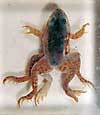
Brandon has spent the past decade studying amphibians which he defined as the “environmental canaries in the coalmine.” They act as bio-sensors. Studies have demonstrated that amphibians are declining even in protected environments. Reports of discovery of frogs which are born with more or sometimes less than 4 legs. With such deformities, the animals have very little chance of survival and the phenomenon might partially explain the decline in amphibian population. Such reports emerged mainly from the US. But declines and deformities of amphibians probably exists on 6 continents. The New York-based artist is currently spending several months in the UK to have a closer look into declining amphibian species, through participatory lab and field-based research investigations. The project is organised by The Arts Catalyst and enabled by residencies at Yorkshire Sculpture Park, Gunpowder Park, and SPACE. He not only works together with scientists but also organizes “eco-actions�? fieldtrips that involve members of the public in his research projects.
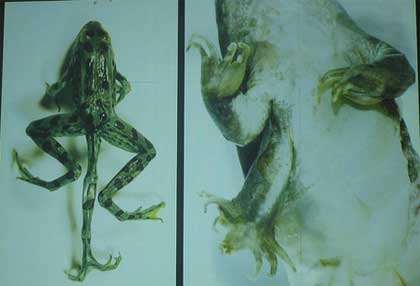
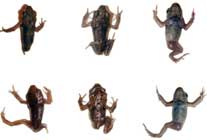 One hypothesis that might explain amphibian deformities is that some parasite inside the body of the frog might hamper its normal development. When amphibians are mutating, they are very sensible to the environment. Brandon made experiments where he would cut one limb of the frog at different stage of its transformation and see it regrow until a rather late stage. If a parasite gobbles its way into the transforming tissues of the mutating frog, it would form a cyst and impede the normal growth of the limbs. The organism of the frog would try to compensate and grow an extra tow or an extra leg coming from the same tissue. This phenomenon of extra limbs is increasing and it compromises the immune system of the amphibian.
One hypothesis that might explain amphibian deformities is that some parasite inside the body of the frog might hamper its normal development. When amphibians are mutating, they are very sensible to the environment. Brandon made experiments where he would cut one limb of the frog at different stage of its transformation and see it regrow until a rather late stage. If a parasite gobbles its way into the transforming tissues of the mutating frog, it would form a cyst and impede the normal growth of the limbs. The organism of the frog would try to compensate and grow an extra tow or an extra leg coming from the same tissue. This phenomenon of extra limbs is increasing and it compromises the immune system of the amphibian.
Brandon has discovered in North Yorkshire many amphibians with just one leg or no leg at all, this phenomenon is not described yet in England. The artist documents the deformities by creating hi-res images using a flat-based scanner (he built an aquarium on top of it).
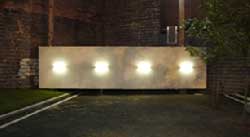 Another of Ballengée’s project, the outdoor installation ‘Love Motels for Insects’, enables the public to study arthropod diversity in urban and natural areas. A blank canvas and ultra-violet (black) light enable the study and photography of arthropods (spiders, moths, beetles, etc.) and other nocturnal creatures. Attracted to the light, the creatures mate and feed on the sculpture. It is a “place for bugs to make more bugs.” Moths release chemical pheromones to attract mates and consequently “paint” the piece, while spiders spin webs adding their own contribution to the work.
Another of Ballengée’s project, the outdoor installation ‘Love Motels for Insects’, enables the public to study arthropod diversity in urban and natural areas. A blank canvas and ultra-violet (black) light enable the study and photography of arthropods (spiders, moths, beetles, etc.) and other nocturnal creatures. Attracted to the light, the creatures mate and feed on the sculpture. It is a “place for bugs to make more bugs.” Moths release chemical pheromones to attract mates and consequently “paint” the piece, while spiders spin webs adding their own contribution to the work.
Brandon uses eco-projects to raise awareness of ecological issues and have people feel part of it. C-lab has a couple of very good images of Brandon Ballangee’s work.
